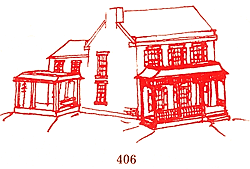 One Click...
One Click...
to all things local!
North 10th Street, A 19th Century Tour
Note: This is the web-based incarnation of a brochure originally published in 1980. While the history is still very valuable, other information may no longer be accurate. Information updated by WayNet will be listed in this orange color.
 N.W. Corner of 10th and D Street (406)
N.W. Corner of 10th and D Street (406)
Pictured below is the residence of Charles West Starr. This modest appearing Federal home is believed to have been constructed in about 1826, when Mr. Starr bought 240 acres from Jeremiah Cox. It was razed in the 1890's for the Richmond Water Works building.
The West in Mr. Starr's name was his mother's maiden name. She was a cousin of Benjamin West, noted Philadelphia painter who moved to England and never returned to the United States.
Before coming to Richmond in 1825 Starr had learned the carpenter's trade in Philadelphia, engaged in the coasting trade between Charleston, S. C.
It was hoped that Richmond would become a manufacturing town and Mr. Starr did a great deal to accomplish this goal. Before he died in 1855, he tried to insure the success of Richmond by donating the land of the Pennsylvania Railroad station as well as land east of it, to
Elizabeth Starr continued where Charles left off and had to deal with some reported rivalry between herself and Robert Morrison, Joseph Plummer, John Smith and others of the west end of Main Street.
The Starrs also operated a popular tavern/hostelry on the old transcontinental highway. It was in operation from 1846 to 1854 and was razed to make room for the Dickinson Trust Building, which has also been razed and is the site of the present Second National Bank Building. (Fifth Third Bank).
Benjamin Starr was also a primary resident at this address. Being born there in 1842, he was the first of the 10 Starr children.
He served in Company C. 2nd Indiana Cavalry in 1861 and was engaged in the skirmishes enroute to Corinth, Pea Ridge, Tuscumbra, McMinnville, and Gallatin. In Gallatin, Benjamin was wounded in the head, was stricken with typhoid fever and fortunately recovered to become secretary and treasurer of Starr Piano Co.
(Revised: He served in Company C, 2nd Indiana Cavalry from September 1861 until September 1862. He was engaged in the skirmishes at Tuscumbia, MS, and McMinnville and Gallatin, TN. At Gallatin Benjamin was wounded in the head and was also stricken with typhoid fever. Fortunately he recovered and became the secretary and treasurer of the Starr Piano Co.)
He was one of the incorporators of the Cincinnati, Richmond and Muncie Railroad.
As a republican, he served as a member of council of administration of the G.A.R., trustee of the Soldiers and Sailor's Orphans Home at Knightstown, member of the board of regents of the Indiana Soldiers and Sailor's monument and as a member of the Richmond School Board.
In 1902 he was elected, unopposed as state senator from Wayne County, but died while in office.
He was married twice, first to Josephine Iredell who died in 1868, then to Mary Longstreet. They had a daughter Lydia who removed to Chicago.
| West Side | East Side |
Text and illustrations © 1980, Old Richmond, Inc.
![]()
![]()
![]()
![]()
Location
North 10th Street, Richmond, Indiana between Main and North E Streets.
Hours / Admission
Public Access / Free
Credit
This information was taken from a brochure copyrighted by Old Richmond, Inc. in 1980.
Permission to publish this information was given to WayNet.org by:
Preserve Richmond
P.O. Box 1709
Richmond, IN 47345
Acknowledgements
~Illustrations and Editor -
Lucian A. Szlizewski
~Old Richmond Board of Directors
~Morrisson-Reeves Library
~Ball State University Library
~Earlham College Library
~Palladium-Item
~Original Brochure Printed by The Graphic Press
|
This jQuery slider was created with the free EasyRotator software from DWUser.com.
Need a powerful Flash slideshow creator with built-in iPhone/iPad/Android support? EasyRotator is supported by the XML Flash Slideshow v4 Software. OK |
This jQuery slider was created with the free EasyRotator software from DWUser.com.
Need a powerful Flash slideshow creator with built-in iPhone/iPad/Android support? EasyRotator is supported by the XML Flash Slideshow v4 Software. OK |
|
This jQuery slider was created with the free EasyRotator software from DWUser.com.
Use WordPress? The free EasyRotator for WordPress plugin lets you create beautiful WordPress sliders in seconds. OK |
This jQuery slider was created with the free EasyRotator software from DWUser.com.
Use WordPress? The free EasyRotator for WordPress plugin lets you create beautiful WordPress sliders in seconds. OK |
Featured Member
Community Photo
More Photos:
Wayne County | WayNet Albums
Did You Know?
Wayne County Fast Facts
| Location: | East Central Indiana, USA |
| Founded: | 1810 |
| Population: | 66,456 |
| Elevation: | 1,257 feet Highest Point in Indiana |
| County Seat: | Richmond |
| Local Time: | |
| Date: | |
| About Indiana: | IN.gov |
| Current Weather: |
Follow Us
Contact Us
| Email: | info@waynet.org |
| Phone: | 765.939.0857 |
| Mail: | 50 North 5th St. Richmond, IN 47374 |
| Director: | Board of Directors |
Stay in Touch
Sign up for WayNet News
- our e-newsletter.
Translate This Page
Join WayNet
About WayNet
Waynet, Inc. is a non-profit, 501(c)4 corporation that is fully-funded through memberships. Please support our members and let them know you located them via WayNet.org.
Top 25: popular pages & circulation information.
Our Recent Tweets
Copyright © Waynet, Inc. 2022, All Rights Reserved.| Policies
Directory | News | Discover | Find It Fast | Knowledge | To Do | Members

























